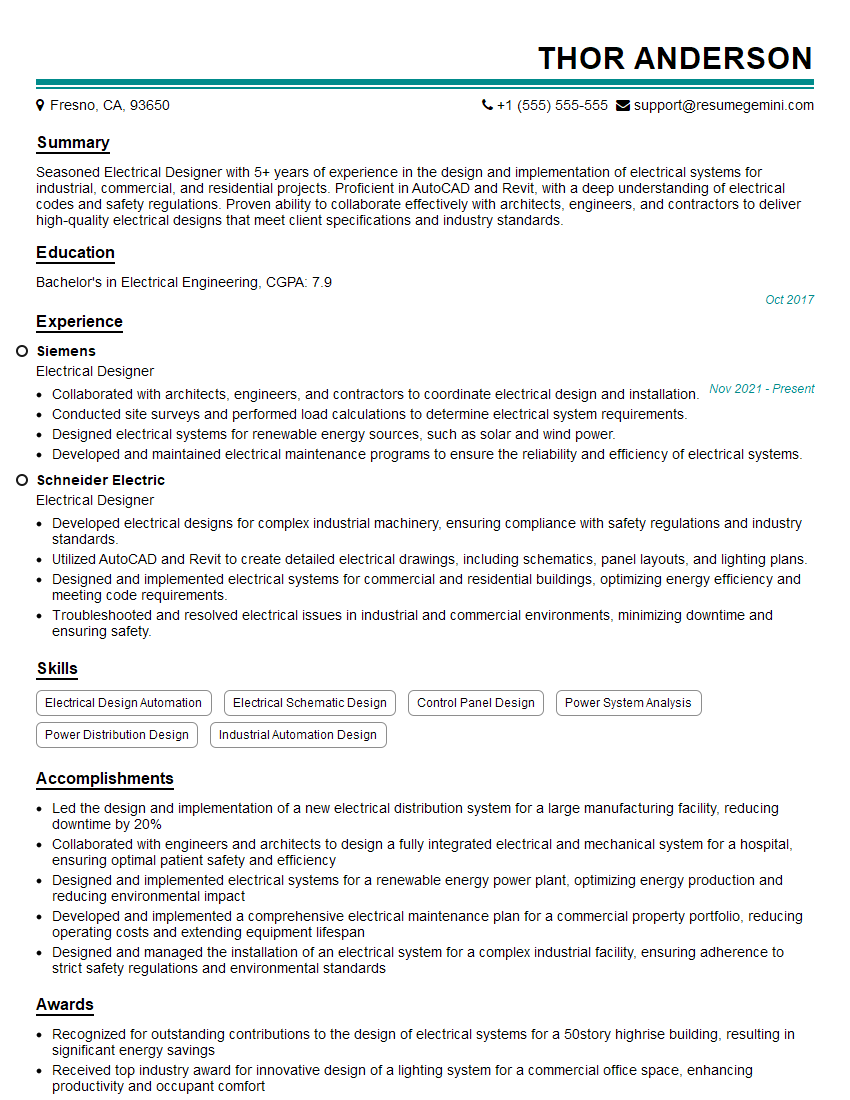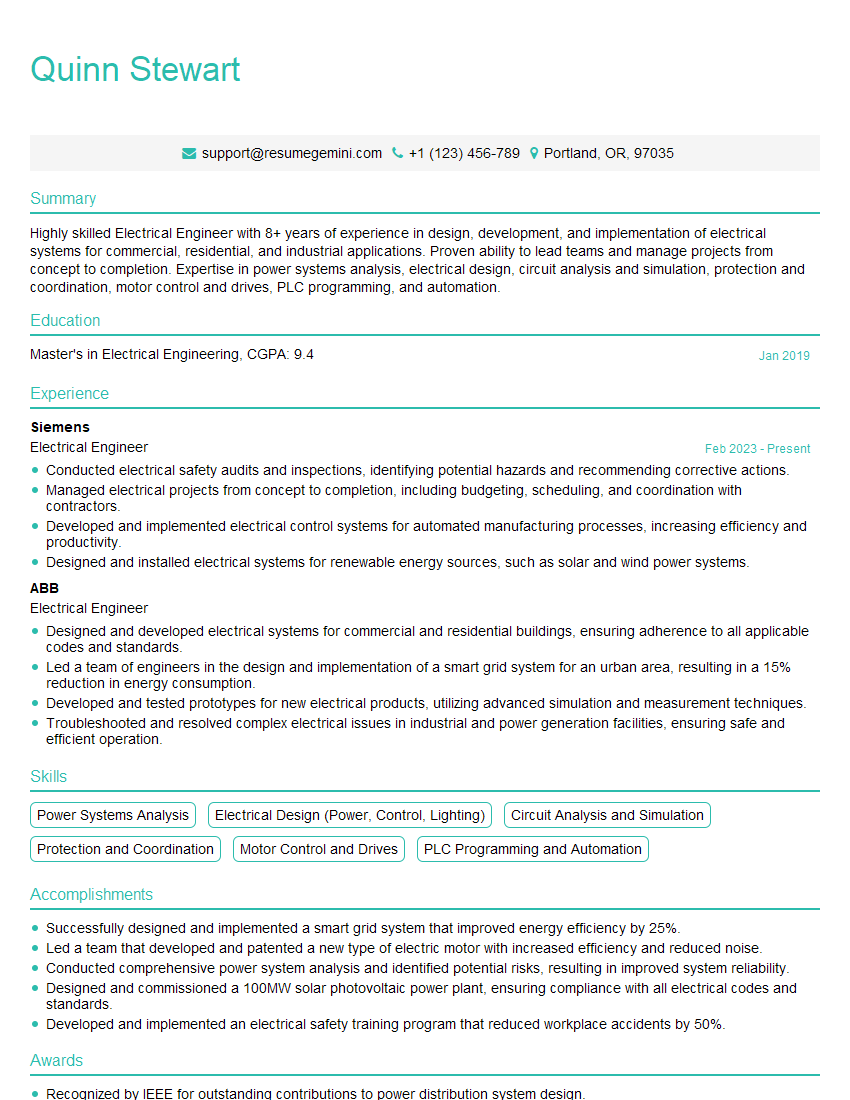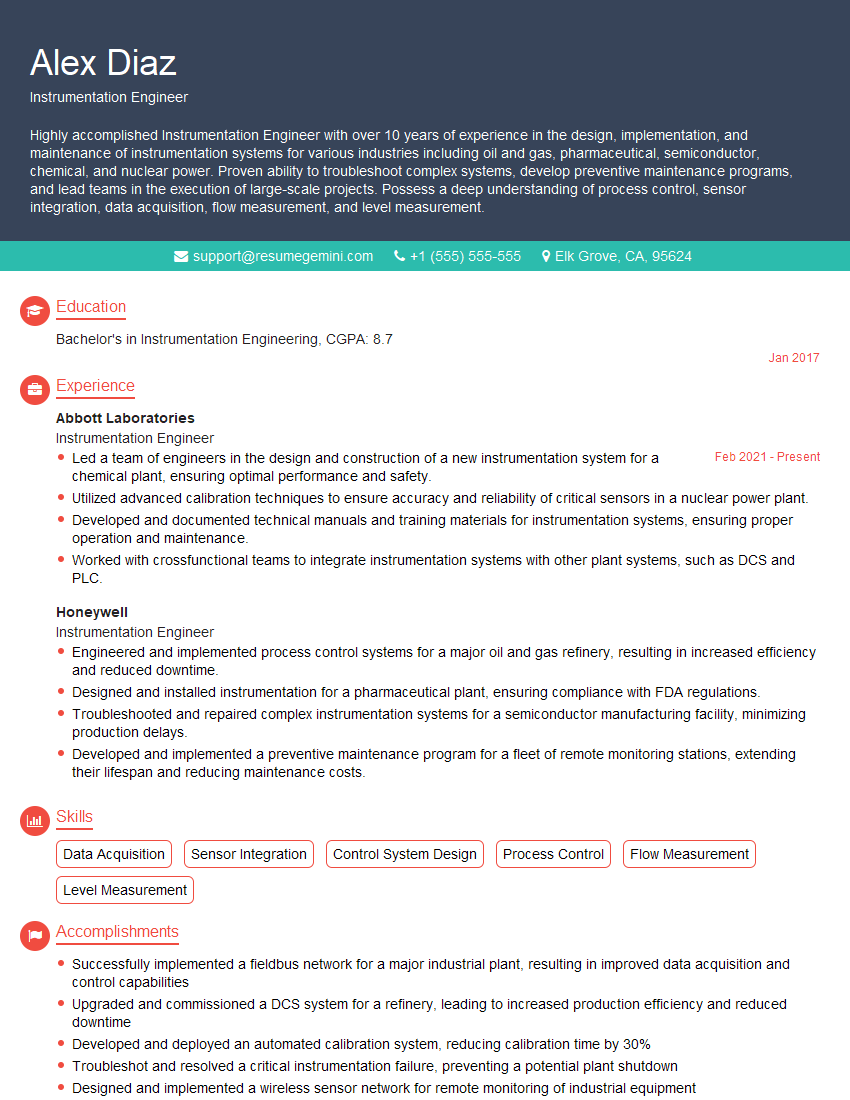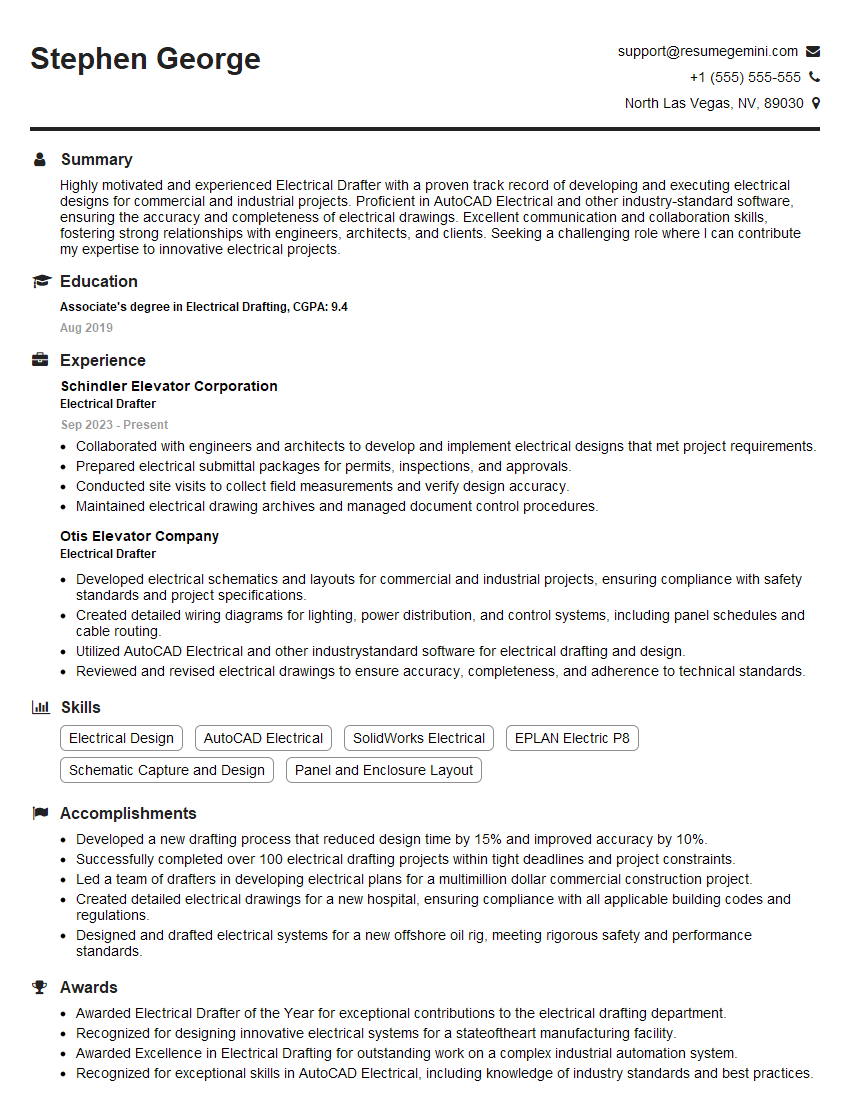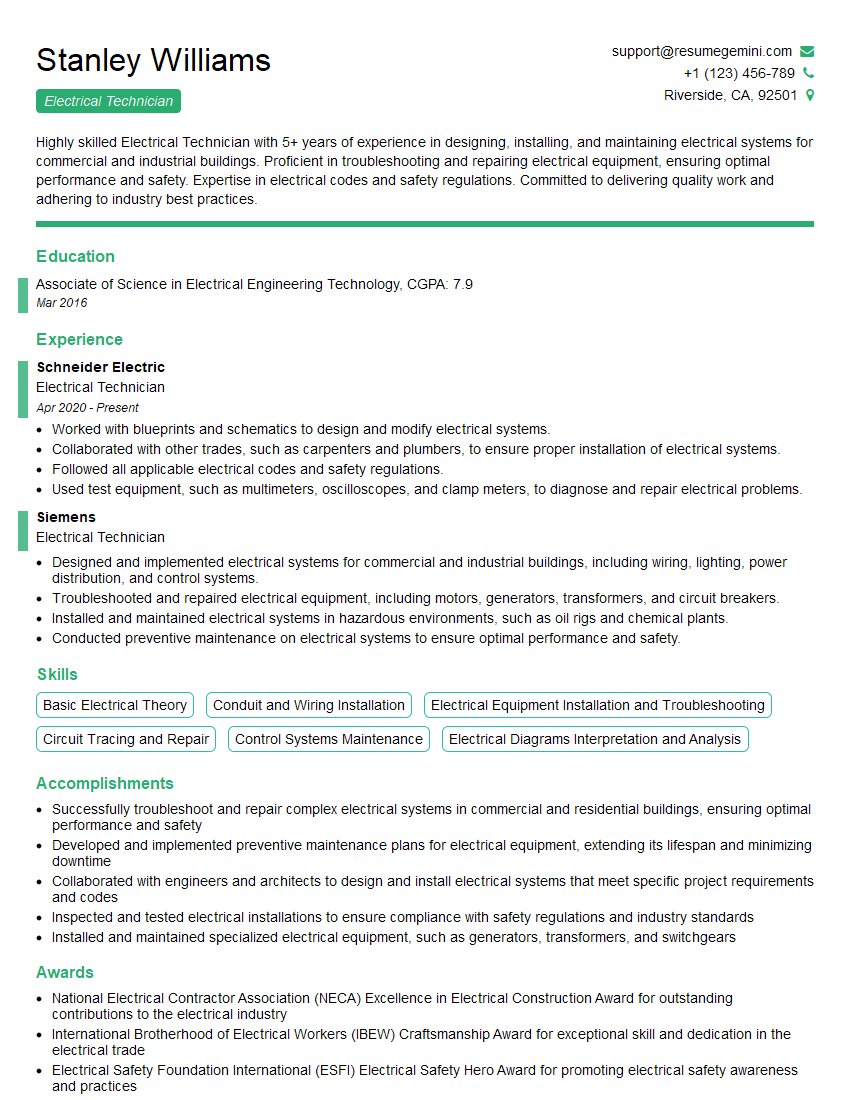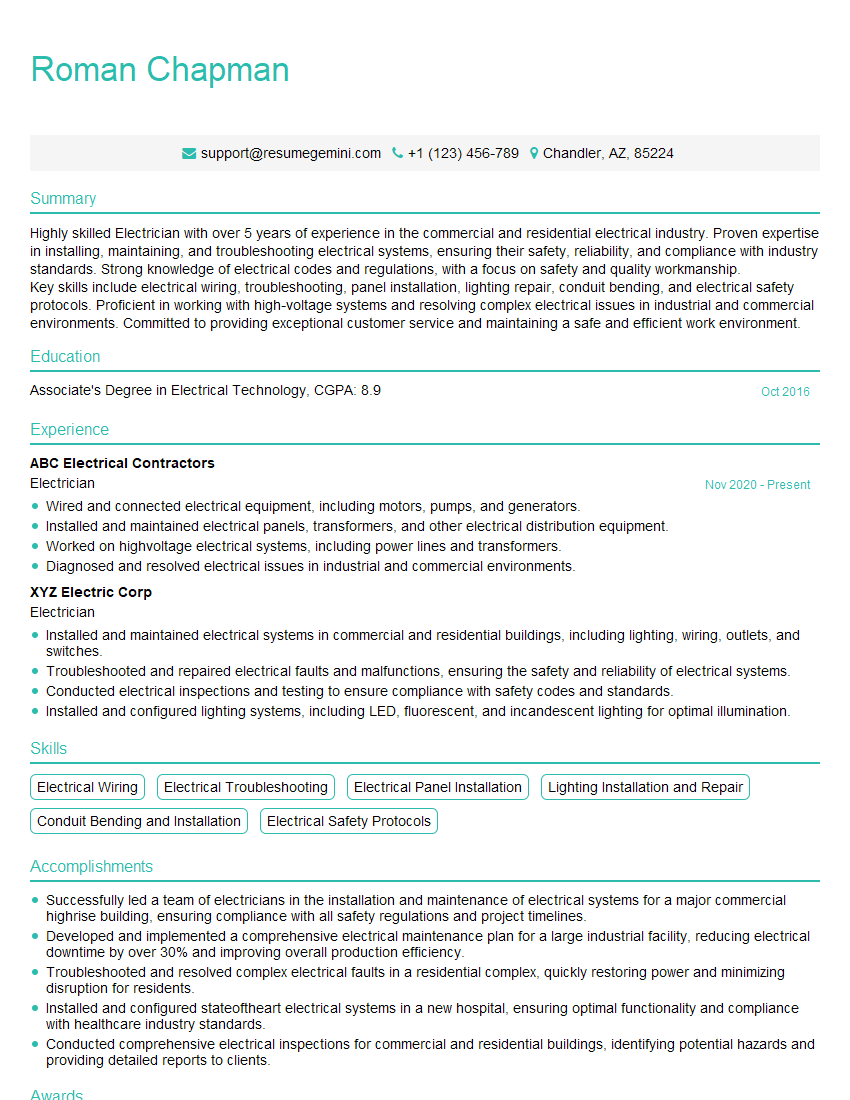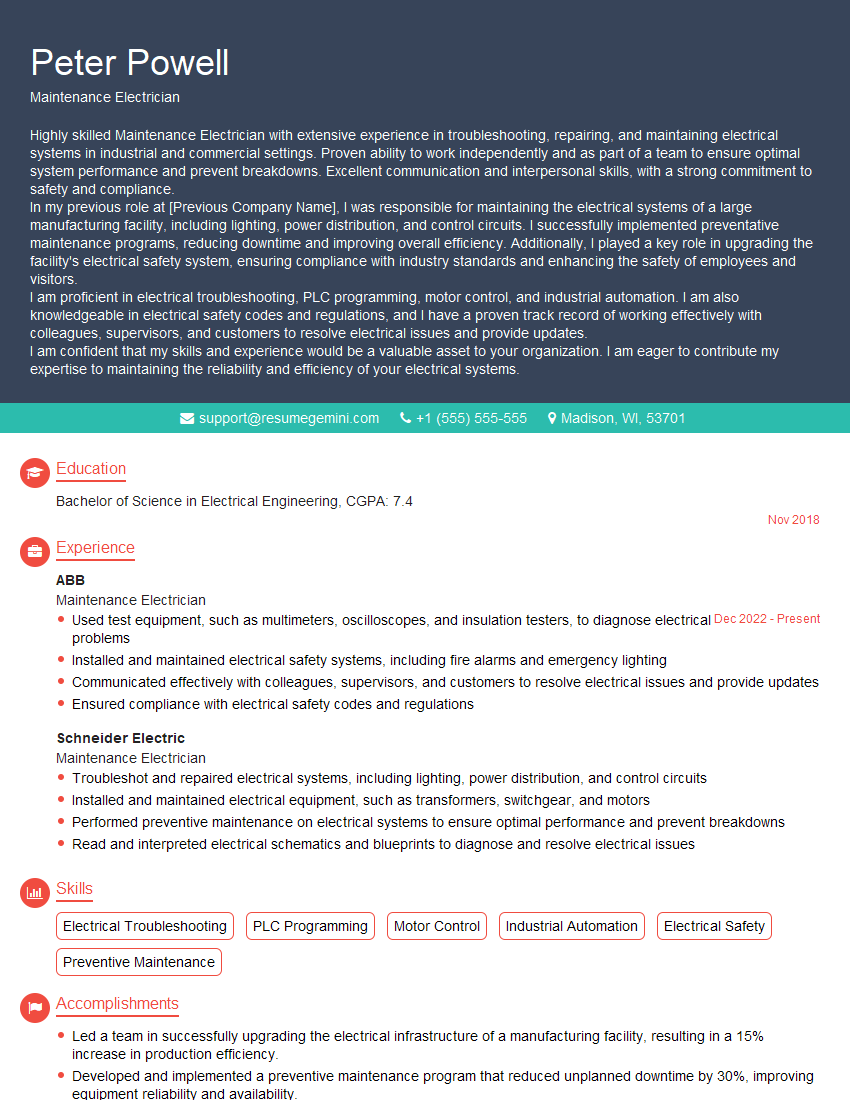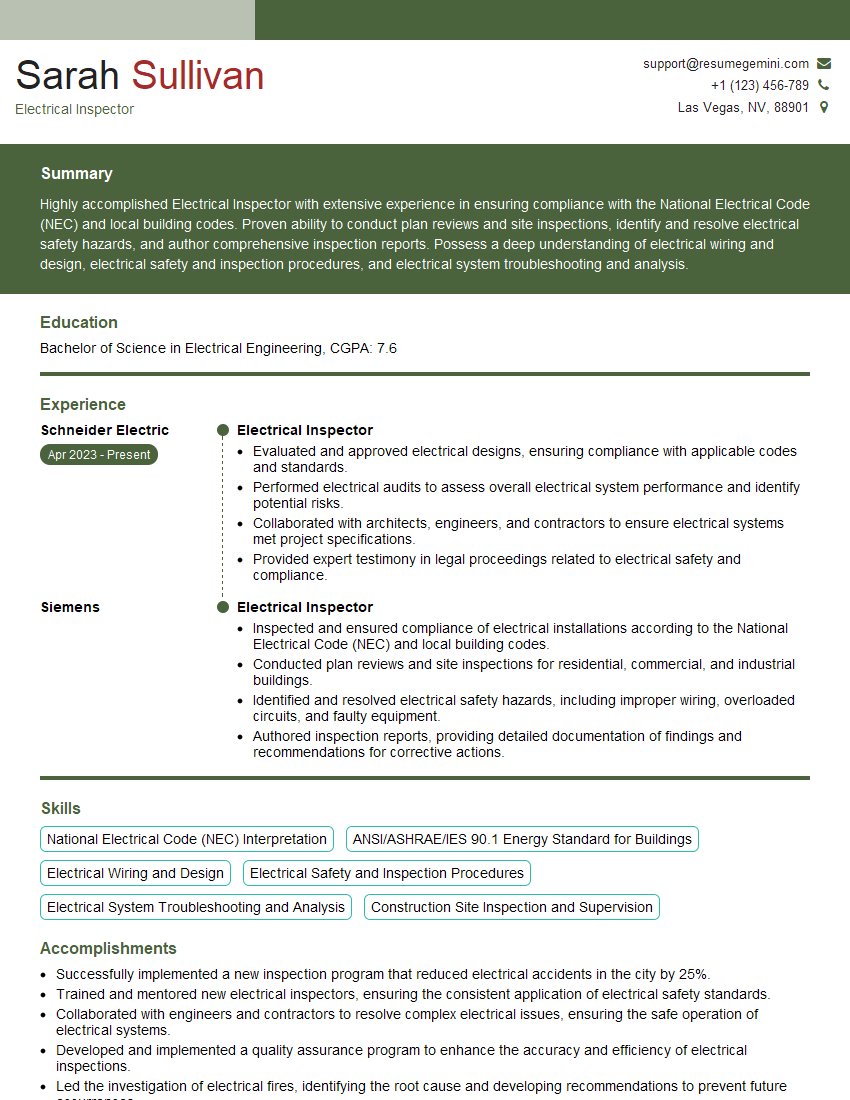The right preparation can turn an interview into an opportunity to showcase your expertise. This guide to Thorough knowledge of electrical systems interview questions is your ultimate resource, providing key insights and tips to help you ace your responses and stand out as a top candidate.
Questions Asked in Thorough knowledge of electrical systems Interview
Q 1. Explain Ohm’s Law and its applications.
Ohm’s Law is a fundamental principle in electrical engineering that describes the relationship between voltage, current, and resistance in an electrical circuit. It states that the current through a conductor between two points is directly proportional to the voltage across the two points and inversely proportional to the resistance between them. This relationship is expressed mathematically as:
V = IR
where:
Vrepresents voltage (measured in volts)Irepresents current (measured in amperes)Rrepresents resistance (measured in ohms)
Applications: Ohm’s Law is incredibly versatile and has numerous applications, including:
- Circuit design: Calculating the required resistance for a specific current and voltage.
- Troubleshooting: Identifying faulty components in a circuit by measuring voltage and current.
- Power calculations: Determining the power dissipated by a resistor (
P = I²R = V²/R). - Lighting systems: Designing lighting circuits with appropriate voltage and current ratings for the lamps.
- Motor control: Calculating the current draw of motors and selecting appropriate power supplies.
For example, if you have a 12V battery and want to power a device that requires 2A, you can use Ohm’s Law to determine the necessary resistance: R = V/I = 12V / 2A = 6 ohms. You would then select a resistor with a resistance of approximately 6 ohms.
Q 2. Describe different types of AC and DC motors.
AC (Alternating Current) and DC (Direct Current) motors differ fundamentally in how they receive and utilize power. AC motors run on alternating current, where the direction of current flow reverses periodically, while DC motors operate on direct current, with a constant flow in one direction.
Types of AC Motors:
- Induction Motors: These are the most common type of AC motor, utilizing the principle of electromagnetic induction to create torque. They are robust, relatively simple, and require minimal maintenance. Subtypes include squirrel-cage and wound-rotor induction motors.
- Synchronous Motors: These motors run at a speed that is synchronized with the frequency of the AC power supply. They are often used in applications requiring precise speed control, such as clocks or high-precision machinery.
- Universal Motors: These motors can operate on both AC and DC power, making them versatile but potentially less efficient than specialized AC or DC motors.
Types of DC Motors:
- Brushed DC Motors: These motors use brushes and commutators to switch the direction of current flow in the rotor windings, creating continuous rotation. They are simple and inexpensive but have limitations regarding speed control and lifespan due to brush wear.
- Brushless DC Motors (BLDC): These motors use electronic commutation instead of mechanical brushes, leading to increased efficiency, longer lifespan, and better speed control. They are often found in high-performance applications like electric vehicles and drones.
- Stepper Motors: These motors rotate in discrete steps, making them ideal for precise positioning applications like robotics and 3D printers.
The choice of motor depends on factors like the application’s power requirements, speed control needs, cost constraints, and maintenance considerations.
Q 3. What are the different types of electrical wiring methods?
Electrical wiring methods are crucial for ensuring safety and efficient power distribution. The choice of method depends on factors such as the application (residential, commercial, industrial), the voltage level, and the environmental conditions.
Common wiring methods include:
- Conduit Wiring: Wires are run inside protective metal or plastic conduits (pipes). This method offers excellent protection against physical damage and environmental factors. It’s commonly used in industrial settings and where durability is paramount.
- Surface Mounting: Wires are run along the surface of walls or ceilings using surface-mounted raceways or cable trays. This is a faster and often cheaper method than conduit wiring, but offers less protection.
- Concealed Wiring: Wires are hidden within walls or ceilings, often within drywall or plaster. This method provides a neat and aesthetically pleasing finish, but access for repairs can be more difficult.
- Cable Tray Wiring: Wires are grouped and supported on metal cable trays. This method is common in larger commercial and industrial installations where many cables need to be routed efficiently.
Each method has its own set of installation standards and safety regulations that must be followed meticulously to prevent electrical hazards. For example, conduit wiring requires specific bending radii to avoid damaging the wires. Similarly, concealed wiring needs proper insulation and protection to avoid fire hazards.
Q 4. Explain the concept of grounding and its importance.
Grounding, also known as earthing, is the process of connecting an electrical system to the earth. This connection provides a low-resistance path for fault currents to flow, preventing dangerous voltage buildup and protecting people and equipment from electrical shocks.
Importance of Grounding:
- Safety: Grounding provides a safe path for fault currents to flow to the earth, preventing dangerous voltages from appearing on exposed metal parts of equipment. If a live wire touches a metal casing, the fault current will flow through the ground wire, tripping a breaker or blowing a fuse, and preventing a shock to anyone touching the casing.
- Equipment Protection: Grounding protects electrical equipment from voltage surges and lightning strikes by providing a path to dissipate the excess energy. This prevents damage to sensitive components and extends the equipment’s lifespan.
- Noise Reduction: Grounding helps reduce electrical noise and interference in sensitive electronic circuits. This is crucial for applications such as audio equipment and computer systems.
Imagine grounding as a safety valve—it releases excess energy harmlessly. Without grounding, a faulty appliance could become dangerously live, posing a serious risk of electric shock.
Q 5. How do you troubleshoot a faulty circuit?
Troubleshooting a faulty circuit requires a systematic approach. Here’s a step-by-step process:
- Safety First: Always disconnect the power supply before starting any troubleshooting. Use a voltage tester to confirm the power is off.
- Visual Inspection: Examine the circuit for any obvious problems, such as loose connections, damaged wires, or burnt components. Look for signs of overheating, such as discoloration or melting.
- Check for Power: Verify the power supply is functioning correctly using a multimeter. Ensure the voltage at the input of the circuit matches the expected voltage.
- Measure Voltage and Current: Use a multimeter to measure the voltage at various points in the circuit, comparing the readings to the expected values. Also, measure the current flowing through different parts of the circuit to identify any unusual high or low currents.
- Isolate the Faulty Component: Use the voltage and current measurements to pinpoint the location of the fault. Start by checking the simplest components first. For example, a simple resistor can be checked with an ohmmeter.
- Replace the Faulty Component: Once the faulty component is identified, replace it with a new one of the same specifications. Always ensure the replacement component is appropriately rated for voltage and current.
- Test the Circuit: After replacing the faulty component, reconnect the power supply and retest the circuit to ensure it’s functioning correctly.
This methodical approach helps isolate the problem quickly and efficiently. For example, if you find no voltage at the output of a power supply but have voltage at its input, the power supply itself is likely faulty. This approach is crucial for resolving electrical problems while ensuring safety and minimizing downtime.
Q 6. What are the safety precautions for working with high voltage systems?
Working with high-voltage systems presents significant risks, demanding strict adherence to safety precautions. Here are some key safety measures:
- Lockout/Tagout Procedures: Always follow established lockout/tagout procedures to ensure the power is completely isolated before working on any high-voltage equipment. This involves physically locking out the power source to prevent accidental energization.
- Personal Protective Equipment (PPE): Use appropriate PPE, including insulated gloves, safety glasses, arc flash suits (depending on the voltage level), and safety footwear. The type and level of protection needed will depend on the voltage level and the nature of the work.
- Proper Training: Only trained and qualified personnel should work on high-voltage systems. They should receive regular refresher training and be fully aware of all safety procedures and potential hazards.
- Use of Insulated Tools: Always use insulated tools rated for the voltage level being worked on. Never use tools with damaged insulation.
- Grounding and Bonding: Ensure proper grounding and bonding techniques are used to prevent the buildup of static electricity and to provide a path for fault currents.
- Emergency Procedures: Be familiar with emergency procedures, including how to respond to electrical shocks or arc flashes. Ensure that appropriate first aid and emergency response plans are in place.
- Work Permits: For many high voltage situations, work permits may be required, with inspections and verifications prior to starting any work
Remember, high-voltage work is inherently dangerous. Prioritizing safety is not just a guideline; it’s a mandatory requirement to protect lives and prevent serious injuries.
Q 7. Explain the principles of circuit breakers and fuses.
Circuit breakers and fuses are both overcurrent protection devices, designed to protect circuits and equipment from damage caused by excessive current flow. However, they operate differently:
Circuit Breakers: Circuit breakers are electromechanical switches that automatically interrupt the flow of current when it exceeds a predetermined level. They contain a bimetallic strip or an electromagnet that triggers a mechanism to open the circuit when an overcurrent occurs. Circuit breakers can be reset after tripping, making them reusable.
Fuses: Fuses are simpler devices containing a thin wire or metal strip that melts and breaks the circuit when the current exceeds its rated value. Fuses are one-time use devices and must be replaced after they blow.
Key Differences:
- Reusability: Circuit breakers can be reset, while fuses must be replaced.
- Speed of Operation: Circuit breakers generally trip faster than fuses, particularly in the event of short circuits.
- Cost: Fuses are typically less expensive than circuit breakers.
- Complexity: Circuit breakers are more complex and sophisticated than fuses.
The choice between a circuit breaker and a fuse often depends on the application and the desired level of protection. Circuit breakers are preferred in situations requiring rapid fault clearing and reusability, while fuses are often suitable for lower-cost, simpler applications.
Q 8. Describe different types of transformers and their applications.
Transformers are essential components in electrical systems, primarily used to change the voltage level of alternating current (AC). They operate on the principle of electromagnetic induction. Different types cater to various needs.
- Power Transformers: These are large transformers used in power transmission and distribution substations. They step-up voltage for long-distance transmission (reducing transmission losses) and then step-down voltage for distribution to consumers. Think of the massive transformers you see near power lines.
- Distribution Transformers: Smaller transformers located on utility poles or underground vaults, stepping down voltage from distribution lines to the voltage used in homes and businesses (e.g., 120/240V in North America).
- Instrument Transformers: Used for measuring high voltages and currents safely. These include current transformers (CTs) which measure current and potential transformers (PTs) which measure voltage, allowing us to use smaller, safer measuring instruments.
- Isolation Transformers: These provide electrical isolation between the primary and secondary circuits. They’re crucial in safety applications to prevent electric shock, often found in medical equipment and laboratories.
- Autotransformers: Have a single winding with a tap used for voltage adjustment. They are smaller and lighter than two-winding transformers for the same power rating, but they lack the isolation provided by a two-winding transformer.
The choice of transformer type depends on the specific application requirements, such as voltage level, power rating, and safety needs.
Q 9. What is the difference between single-phase and three-phase power?
The key difference between single-phase and three-phase power lies in the number of alternating current (AC) waveforms used.
- Single-phase power: Uses a single alternating current waveform. This is what you find in most homes. It’s simpler and less expensive but has limitations in powering larger, high-power equipment.
- Three-phase power: Uses three separate AC waveforms, each offset by 120 degrees. This provides a more efficient and powerful power source, commonly used in industrial settings and for large buildings. It offers smoother power delivery and is more efficient for driving large motors.
Imagine single-phase like a single hose carrying water, while three-phase is like three hoses carrying water simultaneously. Three-phase offers a much higher capacity and more consistent flow.
Three-phase systems also reduce the amount of copper needed for transmission lines, making them cost-effective for long-distance power delivery. This efficiency translates to lower energy costs in industrial applications.
Q 10. Explain the concept of power factor and its correction.
Power factor (PF) represents the ratio of real power (kW) used by a load to the apparent power (kVA) drawn from the supply. It indicates how effectively the electrical power is utilized. A power factor of 1 indicates perfect efficiency, while a lower power factor means more current is drawn than necessary to do the work.
A low power factor is usually caused by inductive loads like motors and transformers which draw reactive power. This reactive power doesn’t do any useful work but contributes to higher currents, increasing losses in cables and equipment.
Power factor correction involves adding capacitive loads (capacitors) to compensate for the inductive reactive power. This improves the power factor, reducing the current drawn from the supply, and decreasing energy loss and cost. Think of it as balancing the scales; the inductive load pulls one way, and the capacitors pull the other way, bringing it closer to equilibrium (a power factor closer to 1).
For example, in a large industrial facility with many motors, adding capacitor banks can significantly improve the power factor, leading to substantial cost savings on electricity bills and reduced stress on the electrical system.
Q 11. Describe different types of electrical relays and their functions.
Electrical relays are electromechanical or electronic switching devices that protect electrical equipment and systems or control their operations. They act as ‘switches’ based on various input conditions.
- Overcurrent Relays: These are the most common type, protecting circuits from excessive current due to overloads or short circuits. They trip the circuit breaker if current exceeds a set value.
- Differential Relays: Compare the current entering and leaving a piece of equipment (like a transformer). If there’s a significant difference, suggesting an internal fault, the relay trips.
- Distance Relays: Measure the impedance of a transmission line to detect faults along its length. They are essential for protecting long transmission lines.
- Thermal Relays: These respond to excessive heat, protecting equipment from overheating. They’re often used with motors.
- Ground Fault Relays: Detect ground faults, protecting personnel and equipment from electric shock. They’re crucial in safety systems.
The selection of a relay depends on the specific protection requirements of the equipment or system. Each relay type is designed to respond to a particular fault condition, ensuring the safety and reliability of the electrical system.
Q 12. How do you calculate the voltage drop in a circuit?
Voltage drop is the reduction in voltage across a circuit element due to the resistance of the conductors. It’s calculated using Ohm’s Law and is crucial for ensuring adequate voltage at the load.
The basic formula is: Voltage Drop (V) = I * R
Where:
- I is the current (in Amperes) flowing through the conductor.
- R is the resistance (in Ohms) of the conductor.
To find the resistance, you can use the formula: R = ρ * L / A
Where:
- ρ is the resistivity of the conductor material (e.g., copper, aluminum).
- L is the length of the conductor.
- A is the cross-sectional area of the conductor.
For example, if you have a circuit with a 10A current flowing through a 2-ohm wire, the voltage drop would be: 10A * 2Ω = 20V. This calculation is essential to ensure sufficient voltage reaches the load, preventing equipment malfunction.
In practice, you must account for the voltage drop in both the supply and return conductors.
Q 13. What are the different types of electrical control systems?
Electrical control systems regulate and monitor the operation of electrical equipment. Several types exist, categorized by their complexity and application.
- Direct Digital Control (DDC): Uses digital computers for control. It offers precise control and flexibility for complex systems, commonly found in HVAC systems of large buildings.
- Programmable Logic Controllers (PLCs): Used in industrial automation, they’re robust and reliable, controlling machinery, processes, and assembly lines.
- Relay Logic Control: Uses electromechanical relays to create control circuits. This is a simpler and more cost-effective approach for smaller applications but is less flexible than DDC or PLC systems.
- Supervisory Control and Data Acquisition (SCADA): Used for large-scale systems like power grids or water treatment plants, allowing centralized monitoring and control of geographically dispersed equipment.
The choice of control system depends on factors like the size and complexity of the system, the required level of control, and the budget.
Q 14. Explain the operation of a PLC (Programmable Logic Controller).
A Programmable Logic Controller (PLC) is a robust industrial computer designed for automation control. It operates by executing a program written in ladder logic (or other programming languages) to control various input/output devices.
A PLC’s operation involves several key steps:
- Input Sensing: The PLC receives signals from sensors and switches representing the state of the controlled process (e.g., temperature, pressure, limit switches).
- Program Execution: The PLC’s CPU executes the programmed ladder logic, which defines the relationships between inputs and outputs.
- Output Control: Based on the program execution, the PLC sends signals to actuators and other output devices, controlling motors, valves, and other equipment.
- Monitoring and Communication: The PLC continuously monitors the process and can communicate with other systems via various communication protocols, providing real-time data and allowing remote control.
Imagine a PLC as the ‘brain’ of an automated manufacturing line. It receives information from sensors about the position of parts, then uses its programmed logic to control robotic arms and conveyor belts to assemble the product. This automation increases efficiency, precision, and safety in industrial processes.
Q 15. Describe your experience with SCADA systems.
My experience with SCADA (Supervisory Control and Data Acquisition) systems spans over eight years, encompassing design, implementation, and maintenance across various industrial settings. I’ve worked extensively with systems ranging from small-scale applications in water treatment plants to large-scale deployments in power generation facilities. My expertise includes configuring PLCs (Programmable Logic Controllers), designing HMI (Human-Machine Interface) screens for intuitive operator control, and integrating various field devices such as sensors, actuators, and RTUs (Remote Terminal Units). For instance, in a recent project involving a wastewater treatment plant, I was responsible for implementing a SCADA system that monitored and controlled the entire process, from influent flow to effluent discharge. This involved programming the PLC to manage pump operations, valve positions, and chemical dosing based on real-time sensor data displayed on the HMI. Troubleshooting network connectivity and data integrity issues were also significant aspects of my responsibilities. I’m proficient in several SCADA software packages, including Wonderware InTouch, Siemens WinCC, and Rockwell FactoryTalk.
Career Expert Tips:
- Ace those interviews! Prepare effectively by reviewing the Top 50 Most Common Interview Questions on ResumeGemini.
- Navigate your job search with confidence! Explore a wide range of Career Tips on ResumeGemini. Learn about common challenges and recommendations to overcome them.
- Craft the perfect resume! Master the Art of Resume Writing with ResumeGemini’s guide. Showcase your unique qualifications and achievements effectively.
- Don’t miss out on holiday savings! Build your dream resume with ResumeGemini’s ATS optimized templates.
Q 16. What are the different types of electrical testing equipment?
Electrical testing equipment is crucial for ensuring safety and functionality in electrical systems. Different types are employed depending on the specific application. Some common examples include:
- Multimeters: These versatile instruments measure voltage, current, and resistance. They are essential for basic circuit testing and troubleshooting.
- Clamp Meters: Used for measuring current without breaking the circuit, making them ideal for high-current applications.
- Meggers (Megohmmeters): Used to measure insulation resistance, helping to identify potential electrical faults and ensuring safety.
- Loop Testers: Essential for testing control loops in industrial automation systems, verifying signal integrity and identifying faults.
- Power Quality Analyzers: Used to measure voltage sags, surges, harmonics, and other power quality disturbances that can impact equipment performance and reliability.
- Digital Ground Testers: Used to test earth ground resistance, ensuring proper grounding and minimizing electrical hazards.
Choosing the right equipment depends heavily on the specific task. For example, when troubleshooting a motor control circuit, I might use a multimeter to check voltage and a clamp meter to measure motor current. If I suspect insulation degradation, a megger is the appropriate tool. The selection process always prioritizes safety and accuracy.
Q 17. Explain the importance of electrical codes and standards.
Electrical codes and standards, such as the National Electrical Code (NEC) in the US or IEC standards internationally, are paramount for ensuring safety, reliability, and consistency in electrical installations and systems. They define best practices, specify acceptable materials, and establish guidelines for design, installation, and maintenance. Compliance with these codes minimizes risks of electrical shocks, fires, and equipment malfunctions. For example, the NEC dictates wire sizing based on current carrying capacity, the type of conduit to be used, and requirements for grounding and bonding. Ignoring these standards can lead to dangerous situations. Moreover, adherence to these codes is frequently a requirement for obtaining permits and insurance, and can even influence the success of insurance claims in case of any mishaps.
Q 18. Describe your experience with electrical CAD software.
I’m highly proficient in several electrical CAD software packages, including AutoCAD Electrical, EPLAN, and SolidWorks Electrical. My experience involves creating detailed electrical schematics, panel layouts, and wiring diagrams for various projects. For example, I recently used AutoCAD Electrical to design the electrical system for a new manufacturing facility, including the power distribution system, motor control centers, and machine control circuits. This involved creating accurate schematics, generating bill of materials, and ensuring compliance with relevant electrical codes and standards. The software’s automation features saved significant time and enhanced accuracy compared to manual drafting.
Q 19. How do you interpret electrical schematics and blueprints?
Interpreting electrical schematics and blueprints requires a thorough understanding of electrical symbols, conventions, and notations. I can readily decipher complex diagrams, identifying components, tracing circuits, and understanding power flows. For instance, I can readily interpret a schematic showing a three-phase motor starter circuit, including the components such as overloads, contactors, and fuses, and understand their interaction and function. I also understand how to use the blueprint to determine physical placement of equipment and wiring routes within a building or facility. My ability to interpret these documents effectively is essential for planning, installation, and troubleshooting.
Q 20. What is your experience with troubleshooting and repairing electrical equipment?
Troubleshooting and repairing electrical equipment is a core part of my expertise. My approach is systematic and methodical, involving a combination of theoretical knowledge and practical skills. I use a combination of diagnostic tools, such as multimeters and clamp meters, to locate faults and identify the root cause of failures. For instance, when a motor failed to start, I systematically checked the power supply, motor windings, starter components, and control circuits, using a multimeter to measure voltages and currents at various points in the circuit. This process allowed me to pinpoint a faulty contactor and replace it, restoring the system to full functionality. Documentation of my findings and repairs is crucial for future reference.
Q 21. Describe your experience with electrical installations.
My experience with electrical installations is extensive, ranging from small-scale residential projects to large-scale industrial installations. I’m familiar with all aspects of the process, from planning and design to installation and testing. For example, I recently led a team in the electrical installation for a new hospital wing. This involved working with blueprints, coordinating with other trades, and ensuring compliance with all relevant codes and standards. The project’s success required meticulous planning, effective communication, and attention to detail throughout the installation process. Rigorous testing and commissioning were conducted to ensure the safety and functionality of the newly installed system. Safety is paramount, and adherence to all relevant safety protocols is always strictly followed.
Q 22. What is your experience with preventative maintenance on electrical systems?
Preventative maintenance on electrical systems is crucial for ensuring safety, reliability, and longevity. It involves a proactive approach, regularly inspecting and servicing equipment to prevent failures before they occur. This includes tasks like:
- Visual Inspections: Checking for loose connections, damaged insulation, corrosion, and overheating.
- Testing: Using multimeters and other instruments to measure voltage, current, resistance, and insulation resistance to identify potential problems before they escalate.
- Cleaning: Removing dust and debris from electrical components to improve heat dissipation and prevent arcing.
- Lubrication: Lubricating moving parts of electrical equipment, such as motor bearings, to ensure smooth operation and extend lifespan.
- Tightening Connections: Ensuring all connections are securely tightened to prevent loose contacts and potential fire hazards.
For instance, in a large industrial facility, a preventative maintenance program might involve regularly inspecting and testing high-voltage switchgear, transformers, and motor control centers. Early detection of a failing transformer, for example, could prevent a costly and disruptive power outage.
Q 23. Explain your understanding of renewable energy systems.
Renewable energy systems harness naturally replenishing resources to generate electricity. These systems are crucial for reducing our reliance on fossil fuels and mitigating climate change. My understanding encompasses several key technologies:
- Photovoltaic (PV) Systems: These systems use solar panels to convert sunlight directly into electricity. I’m familiar with different PV technologies, including monocrystalline, polycrystalline, and thin-film solar cells, and their respective efficiency and cost considerations.
- Wind Energy Systems: Wind turbines convert kinetic energy from wind into electricity. My knowledge extends to different turbine designs, including horizontal-axis and vertical-axis turbines, and their suitability for various wind conditions.
- Hydropower Systems: These systems utilize the energy of moving water to generate electricity. I understand different types of hydropower plants, including run-of-river, impoundment, and pumped storage systems.
- Geothermal Energy Systems: Geothermal systems harness heat from the Earth’s interior to generate electricity. I am familiar with various geothermal power plant designs and their environmental impacts.
- Biomass Energy Systems: Biomass systems use organic matter to generate electricity through combustion or gasification. I understand the different types of biomass fuels and their energy conversion technologies.
I also understand the challenges associated with renewable energy integration, such as intermittency, grid stability, and energy storage. Designing efficient and reliable systems that address these challenges requires a thorough understanding of power electronics, grid management, and energy storage technologies.
Q 24. How do you ensure safety compliance in electrical work?
Safety compliance in electrical work is paramount. It’s not just about following regulations; it’s about protecting lives and preventing accidents. My approach is multifaceted:
- Adherence to Codes and Standards: I strictly follow all relevant electrical codes and standards, such as the National Electrical Code (NEC) and relevant Occupational Safety and Health Administration (OSHA) regulations.
- Lockout/Tagout Procedures: I always employ proper lockout/tagout procedures to de-energize equipment before working on it, preventing accidental energization and ensuring worker safety.
- Personal Protective Equipment (PPE): I consistently use appropriate PPE, including insulated gloves, safety glasses, and arc flash protective clothing, depending on the task.
- Risk Assessment: I perform thorough risk assessments before undertaking any electrical work to identify potential hazards and implement appropriate safety measures.
- Proper Training and Certification: I maintain up-to-date training and certifications relevant to my work, demonstrating my commitment to safe practices.
For example, before working on a high-voltage panel, I’d meticulously follow lockout/tagout procedures, verifying the absence of voltage using a non-contact voltage tester before commencing any work. Regular safety training and awareness are essential in maintaining a safe working environment.
Q 25. Describe a challenging electrical problem you solved and how you approached it.
In a previous role, I encountered an intermittent short circuit in a complex industrial control system. The problem was difficult to diagnose because the short only occurred under specific load conditions, making it hard to pinpoint the location. My approach was systematic:
- Documentation and Data Collection: I meticulously documented the system’s wiring diagrams, component specifications, and the conditions under which the short occurred. I also collected data using oscilloscopes and current clamps to observe the electrical behavior during the fault.
- Isolation and Testing: I systematically isolated sections of the circuit to narrow down the area of the fault. I used a combination of visual inspection and targeted testing with a multimeter and insulation tester.
- Systematic Troubleshooting: I employed a process of elimination, starting with the most likely causes and working my way through the system. This involved checking all connections, components, and wiring in the suspect area.
After several days of rigorous investigation, I finally identified a damaged wire hidden beneath a cable tray. The wire insulation had deteriorated, causing the intermittent short. Replacing the damaged wire completely resolved the issue. This experience highlighted the importance of detailed documentation, thorough testing, and a methodical troubleshooting approach.
Q 26. What are your strengths and weaknesses in electrical engineering?
My strengths lie in my analytical skills, problem-solving abilities, and methodical approach to troubleshooting complex electrical systems. I excel at understanding intricate systems, identifying root causes of malfunctions, and developing effective solutions. I’m also a quick learner and adept at adapting to new technologies.
A potential weakness is my tendency to be meticulous, which can sometimes lead to taking longer than necessary to complete a task. However, I’m actively working on improving my time management skills while maintaining the high standard of work I strive for.
Q 27. Where do you see yourself in 5 years in the field of electrical engineering?
In five years, I see myself as a highly skilled and experienced electrical engineer, potentially leading projects or mentoring junior engineers. I’m eager to expand my expertise in renewable energy systems and contribute to the development of sustainable energy solutions. I also aspire to take on more responsibility and contribute significantly to the success of my team and organization.
Q 28. What are your salary expectations?
My salary expectations are in line with the industry standards for an electrical engineer with my experience and skills. I’m open to discussing this further based on the specifics of the role and compensation package.
Key Topics to Learn for Thorough Knowledge of Electrical Systems Interviews
- Fundamentals of Electricity: Ohm’s Law, Kirchhoff’s Laws, basic circuit analysis (series, parallel, and complex circuits). Understand the theoretical underpinnings and how they apply in real-world scenarios.
- AC/DC Circuits: Differences between AC and DC power, characteristics of waveforms, rectification, and applications of each in various systems. Be prepared to discuss practical implications of choosing one over the other.
- Power Systems: Transformers (types, operation, applications), power generation (various methods), transmission and distribution networks, power factor correction. Consider examples of challenges and solutions within power distribution.
- Electrical Machines: Motors (DC, AC induction, synchronous) and generators, their principles of operation, torque-speed characteristics, and applications. Be ready to explain the selection criteria for different motor types.
- Control Systems: Basic understanding of feedback control systems, PID controllers, and their use in regulating electrical systems. Prepare examples of applications in industrial automation or similar.
- Protection and Safety: Overcurrent protection devices (fuses, circuit breakers), grounding techniques, safety regulations and standards (e.g., NEC). Discuss practical safety measures and their importance.
- Troubleshooting and Diagnostics: Methods for identifying and resolving electrical faults using multimeters, oscilloscopes, and other diagnostic tools. Be prepared to discuss your problem-solving approach in a practical context.
- Renewable Energy Systems: Solar photovoltaic systems, wind turbines, and other renewable energy technologies; their integration into the electrical grid and associated challenges.
Next Steps
Mastering a thorough knowledge of electrical systems is crucial for career advancement in this dynamic field. It opens doors to specialized roles, higher earning potential, and greater influence on innovative projects. To maximize your job prospects, a well-crafted, ATS-friendly resume is essential. ResumeGemini is a trusted resource that can help you build a professional resume that highlights your skills and experience effectively. Examples of resumes tailored to showcasing thorough knowledge of electrical systems are available through ResumeGemini to guide your creation process.
Explore more articles
Users Rating of Our Blogs
Share Your Experience
We value your feedback! Please rate our content and share your thoughts (optional).
What Readers Say About Our Blog
Live Rent Free!
https://bit.ly/LiveRentFREE
Interesting Article, I liked the depth of knowledge you’ve shared.
Helpful, thanks for sharing.
Hi, I represent a social media marketing agency and liked your blog
Hi, I represent an SEO company that specialises in getting you AI citations and higher rankings on Google. I’d like to offer you a 100% free SEO audit for your website. Would you be interested?

